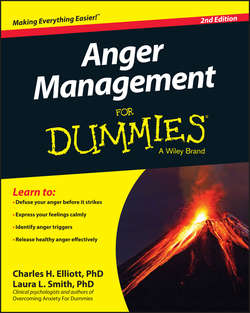Читать книгу Anger Management For Dummies - W. Doyle Gentry - Страница 15
На сайте Литреса книга снята с продажи.
Part I
Getting Started with Anger Management
Chapter 2
Finding Your Anger Profile
Exploring Anger Feelings: Frequency, Intensity, and Duration
ОглавлениеTo understand how much of a problem you have with anger, you need to look at how frequently you experience the emotion, how long it lasts, and how intensely you feel it. Obviously, if you feel frequent, intense, and long-lasting anger, you have a problem, and your anger likely interferes with your life and relationships. Ask yourself the following questions:
✔ How frequently do I feel irritated, annoyed, or angry? Generally, if you experience angry feelings more than two or three times a week, it’s probably a good idea to look at whether you have situations or stressors that need to be addressed. However, your anger intensity and duration may matter more.
✔ Just how mad do I get? Everyone gets annoyed from time to time. And frankly, most people experience anger here and there. But most people don’t punch holes in walls or aggressively threaten people. The intensity of your anger is excessive if you become violent, hysterical, vicious, scary to other people, or out of control. There’s no really simple, valid, numerical scale of how much anger is too much, but you get the idea.
✔ How long do I stay mad? Some people get over their anger quickly. Others dwell and ruminate for hours, days, or even longer, sometimes for years. Once we took a cruise and had an Eastern European waiter. He bitterly complained about Barbarians who had butchered his family. We expressed shock and concern. Then the waiter went on to say that this butchery had happened in the tenth century. That’s a long time to hold onto a grudge!
Negative emotions like anger are normal parts of human experience. Anger becomes a problem when it detracts from the quality of your work, pleasure, and relationships.
State versus trait anger
Anger specialists have described the difference between what’s known as state and trait anger.
✔ Trait anger refers to a chronic, long-standing personality characteristic that shows up as an almost constant tendency to become angry at the slightest provocation. People with high trait anger have very low boiling points. People with high trait anger run into lots of interpersonal conflicts, problems at work, and health problems.
✔ State anger refers to temporary, short-lasting outbursts of anger. These episodes are considered appropriate in many situations and often call for problem solving. The appearance of occasional state anger responses is a normal part of life unless the intensity, frequency, and duration are way out of proportion to the triggering event.
The relationship of state and trait anger is much like the connection between weather and climate. Climate and trait anger both represent long-standing patterns, such as the climate in Alaska tends to be rather cold. State anger is like weather, which can change quickly from one day to another. Thus, where we live in New Mexico, the climate is quite dry, but major thunderstorms can pop up from time to time, causing floods and mayhem. Those occasional storms don’t mean that the climate has changed in the state.
Note: We aren’t trying to dredge up the climate change debate here, so don’t get mad!
